Table of Contents
OSPF Area Type
By dividing the OSPF network into areas, OSPF-based routing can be performed efficiently in large networks. There are several types of areas, as follows
- Backbone area
- Normal area
- Stub area
- Normal stub
- Totally stub
- NSSA(Not So Stuby Area)
- Totally NSSA
This section describes the characteristics of these areas and the types of LSAs that flow in the areas.
Related article
In order to understand the contents of this page, it is recommended to read the following pages as well.
Backbone Area
The backbone area is the central area of the OSPF area. Make sure to use two layers with the backbone area as the center. The area ID of the backbone area is 0 (0.0.0.0). And the LSAs advertised in the backbone area are LSA type 1 to type 5. LLSA type 1 and LSA type 2 represent the details in the area. LSA type 3 represents the network address of the other area, LSA type 4 represents the ASBR that borders the non-OSPF domain, and LSA type 5 represents the network address of the non-OSPF domain.
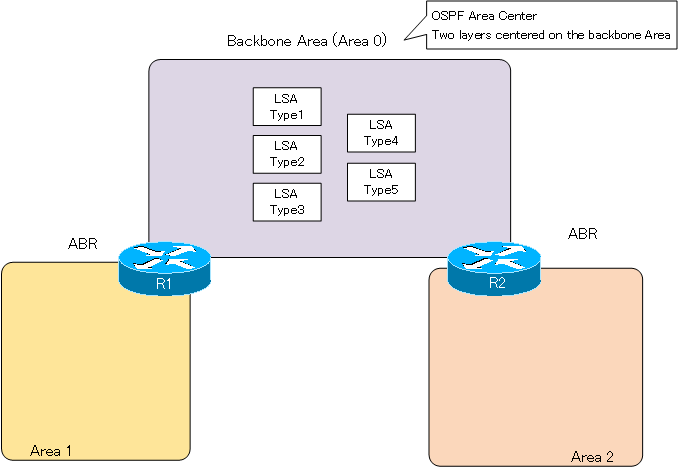
The reason why OSPF areas must be in two layers, with the backbone area at the center, is because of the treatment of LSA type 3 in the backbone area; LSA type 3 represents the network address of the other area. Only the backbone area will advertise the LSA type 3, which represents the network address of one area, to a more different area. This is to ensure that inter area routes do not loop.
As a simple example, consider the following diagram. R1 is the ABR that connects Area 1 to the backbone area. Also, R2 is the ABR that connects Area 2 to the backbone area. R1 generates an LSA type 3 representing the network address 10.1.1.0/24 in area 1 and advertises it to the backbone area. Then, R2 generates and advertises LSA type 3, which represents the network address 10.0.1.0/24 of area 0, and LSA type 3, which represents the network address 10.1.1.0/24 of area 1, to the LSDB in area 2.
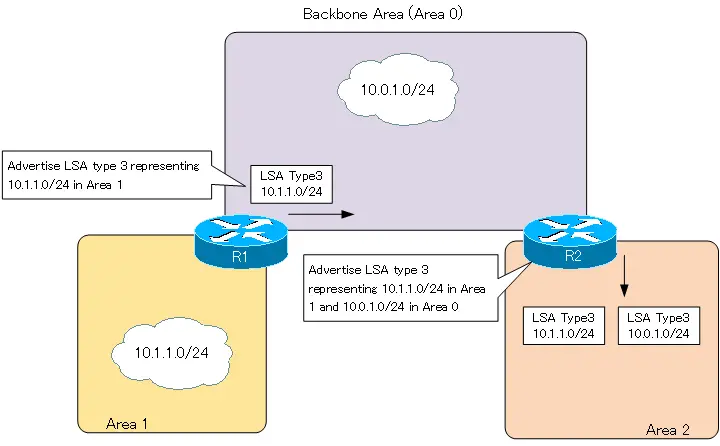
Normal area
The area that connects to the backbone area is the normal area. LSA type 1 to type 5 flow into the norm al area. As a rule, it is not possible to connect more areas to the normal area.
Stub area
The stub area is the area where the LSAs flowing in the area are aggregated. The LSA Type 1/Type 2 advertisements, which represent the details in the area, are the same as the backbone area and normal area. By making the area as stub area, it aggregates LSA type 3/type 4/type 5 for other areas and non-OSPF domains.
The word “stub” is used in many ways. Think of a “stub” here as a network of small sites. Smaller networks are usually not redundant. In most cases, there is only one ABR as an exit. OSPF routers in such a stub area are not very useful even if they have fine-grained LSAs. When routing packets to a network outside the stub area, just forward them to the ABR that will be the exit from the stub area. So, it is OK to aggregate the LSAs to be advertised in the stub area.
In addition, the stub area has the following restrictions
- ASBRs cannot be placed.
- Cannot make transit area of virtual-link
As mentioned earlier, stub areas are intended for networks of small sites. This is because no other area or network in a non-OSPF domain is to be connected beyond such a stub area. There are several more types of stub areas, as follows
- Normal stub
- Totally stub
- NSSA(Not So Stuby Area)
- Totally NSSA
Normal stub
The normal stub is an area where LSA type 5, which represents a non-OSPF domain network, is not advertised. Also, if LSA type 5 is not advertised, then LSA type 4 is not necessary. The normal stub area is advertised with LSA type 1 and LSA type 2, which represent the details in the area, and LSA type 3, which represents the network addresses in other areas.
Networks in the non-OSPF domain exist outside the stub area. Whenever a packet is routed to a network in a non-OSPF domain, it will be forwarded to the ABR. Therefore, it doesn’t make much sense for an OSPF router in a normal stub area to have LSA type 5. Instead of advertising the fine LSA type 5, the ABR advertises the default route with LSA type 3. This means that routes from non-OSPF domains are aggregated to the default route.
The following figure briefly summarizes the LSAs that will be advertised when area 2 in the lower right corner is used as the normal stub.
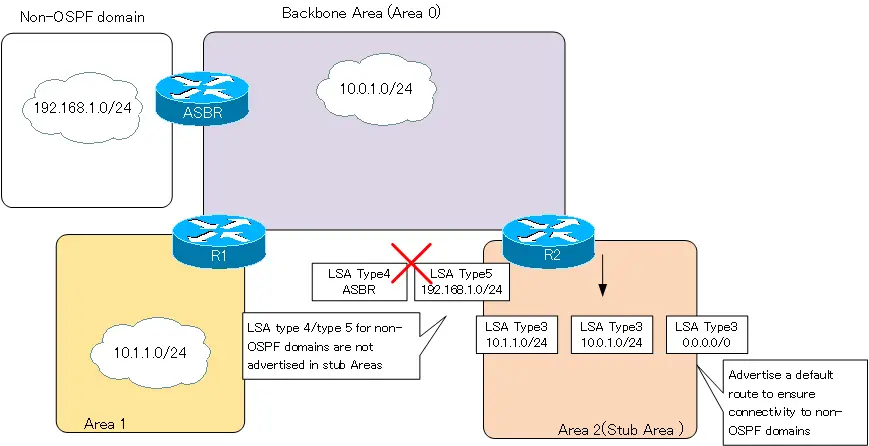
Totally stub
The Totally Stub is an area with more reduced LSAs to be advertised from the normal stub area. LSA type 4/5 as well as LSA type 3 representing individual networks in other areas will not be advertised in the Totally Stub. They are all aggregated into a default route.
Even when routing packets to other area networks, they will eventually just be forwarded to the ABR. Therefore, there is no need for LSA type 3, which represents networks in other areas. To ensure connectivity to networks in other areas, the ABR in the Totally Stub area advertises the default route as LSA type 3.
The following figure briefly summarizes the LSAs that are advertised when Area 2 in the lower right is used as the Totally Stub.
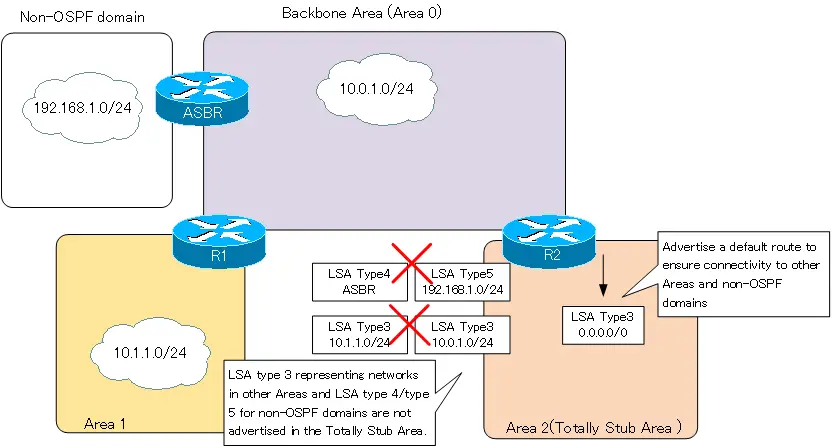
Totally stubs are said to be proprietary to Cisco, but the same configuration can be used by non-Cisco vendors.
NSSA
NSSA mitigates the stub area restriction that “ASBRs cannot be placed”. ASBRs are placed within NSSA to allow non-OSPF domain networks to be connected. The same feature of not advertising LSA type 5 and LSA type 4 in the normal stub is used.
Connect a network in a non-OSPF domain ahead of the NSSA, and redistribute the routes in the non-OSPF domain to the NSSA in the ASBR. In this case, LSA type 7 representing a network in non-OSPF domain is generated. LSA type 7 is advertised only within the NSSA; the NSSA’s ABR converts LSA type 7 to LSA type 5 and advertises it to the backbone area. This allows OSPF routers outside of the NSSA to ensure connectivity to non-OSPF domain networks that are connected beyond the NSSA.
Note that NSSA does not automatically generate a default route; you need to explicitly configure NSSA to generate a default route.
The following figure briefly summarizes the LSAs that will be advertised when area 2 in the lower right corner is used as the NSSA.
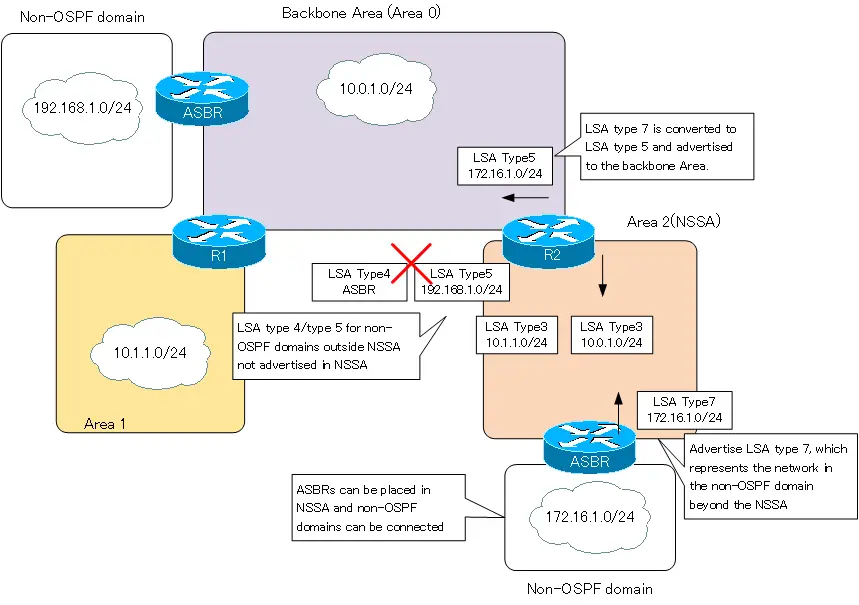
Totally NSSA
Totally NSSA is the NSSA version of Totally Stub. Just like NSSA, you can deploy ASBRs to connect networks in non-OSPF domains. Then you can aggregate all LSA type 3s that represent networks in other areas into a default route, just like Totally Stub.
The following figure briefly summarizes the LSAs that will be advertised when area 2 in the lower right is the Totally NSSA.
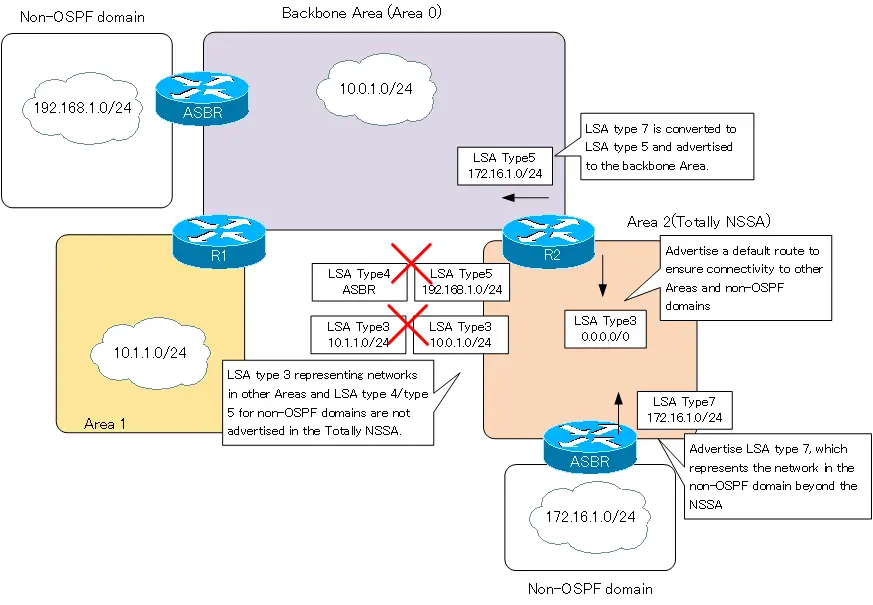
Related article
The following article explains in detail about configuring and verifying stub/totally stub/NSSA/totally NSSA on Cisco routers.
How the OSPF works
- OSPF Overview
- OSPF process flow
- OSPF Router ID : Identify OSPF routers
- What if the router ID of the OSPF router is duplicated?
- OSPF Neighbor and Adjacency
- OSPF DR/BDR
- How show ip ospf neighbor looks on Ethernet
- OSPF Network Type : Classification of OSPF-enabled interfaces
- Synchronization process of OSPF LSDB
- Problems with large-scale OSPF network
- OSPF Area – Inside the area, in detail; outside the area, just a summary
- OSPF Router Type
- OSPF LSA Type
- OSPF Area Type
- OSPF Basic Configuration and Verification Commands
- Details of enabling OSPF on the interface
- OSPF Advertising Loopback Interface
- Configuring and Verifying OSPF Hello/Dead interval
- OSPF Cost Configuration and Verification
- Configuring and Verifying OSPF Router Priority
- Configuring OSPF Neighbor Authentication
- Neighbor Authentication over Virtual-link
- OSPF Configuring and Verifying Stub area [Cisco]
- OSPF Stub Area Configuration Example [Cisco]
- OSPF default route generation : default-information originate command
- Configuration Example of OSPF default route generation : stub area
- OSPF Virtual-Link : Virtual area 0 point-to-point link
- Configuring and Verifying OSPF Virtual-link [Cisco]
- OSPF Virtual-link Configuration Example [Cisco]
- OSPF Virtual-link for discontinuous backbone configuration example
- OSPF Route Summary and Configuration
- Cisco OSPF Route Summary Configuration Example
- OSPF Route Type Preference
- Why the OSPF neighbor state gets stuck in Exstart?
- OSPF packet type and header format
- OSPF Hello Packet
- OSPF DD(Database Description) Packet
- OSPF LSR(Link State Request) Packet
- OSPF LSU(Link State Update) Packet
- OSPF LSAck(Link State Acknowledgement) Packet
- Limitation of OSPF redistribution routes – redistribute maximum-prefix command
- Overview of LSA Filters for OSPF – Filter LSA Type 3/Type 5
- Configuration example of LSA type 3 filter
- Configuration example of LSA type 5 filter
- OSPFv3 Configuration Example [Cisco]
- Configuration Example of OSPFv3 Route Summary [Cisco]



